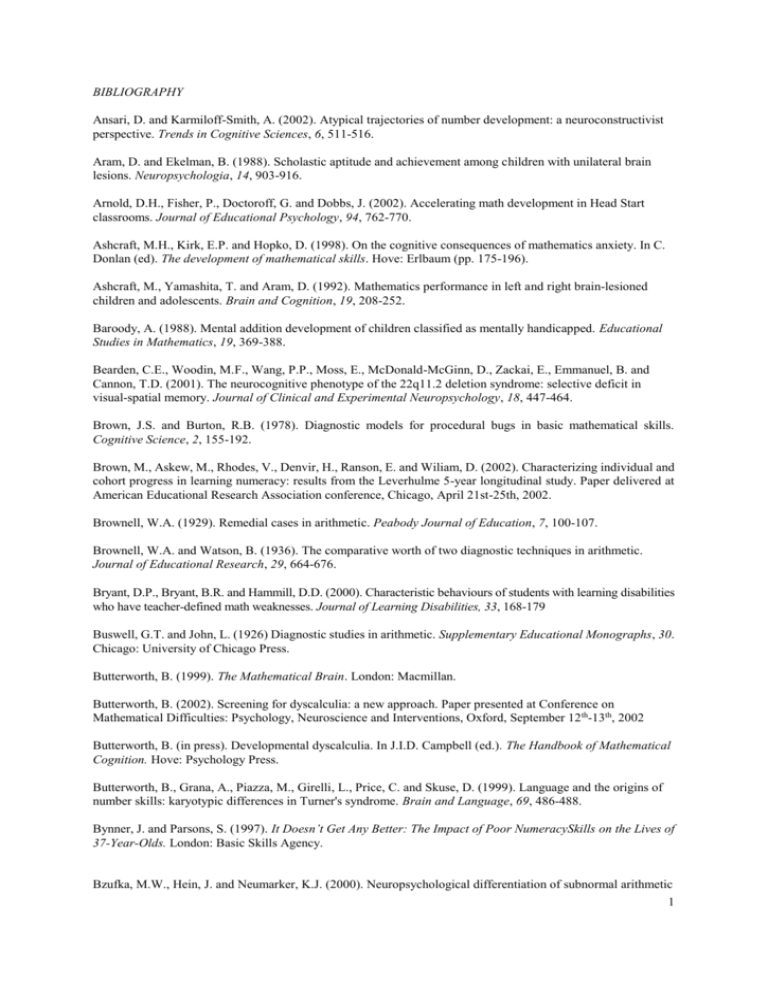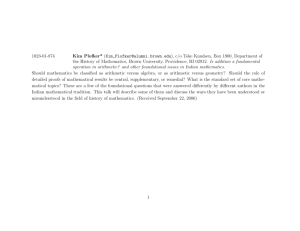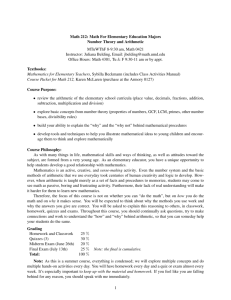References for this paper - Oxford Brookes University
advertisement

BIBLIOGRAPHY Ansari, D. and Karmiloff-Smith, A. (2002). Atypical trajectories of number development: a neuroconstructivist perspective. Trends in Cognitive Sciences, 6, 511-516. Aram, D. and Ekelman, B. (1988). Scholastic aptitude and achievement among children with unilateral brain lesions. Neuropsychologia, 14, 903-916. Arnold, D.H., Fisher, P., Doctoroff, G. and Dobbs, J. (2002). Accelerating math development in Head Start classrooms. Journal of Educational Psychology, 94, 762-770. Ashcraft, M.H., Kirk, E.P. and Hopko, D. (1998). On the cognitive consequences of mathematics anxiety. In C. Donlan (ed). The development of mathematical skills. Hove: Erlbaum (pp. 175-196). Ashcraft, M., Yamashita, T. and Aram, D. (1992). Mathematics performance in left and right brain-lesioned children and adolescents. Brain and Cognition, 19, 208-252. Baroody, A. (1988). Mental addition development of children classified as mentally handicapped. Educational Studies in Mathematics, 19, 369-388. Bearden, C.E., Woodin, M.F., Wang, P.P., Moss, E., McDonald-McGinn, D., Zackai, E., Emmanuel, B. and Cannon, T.D. (2001). The neurocognitive phenotype of the 22q11.2 deletion syndrome: selective deficit in visual-spatial memory. Journal of Clinical and Experimental Neuropsychology, 18, 447-464. Brown, J.S. and Burton, R.B. (1978). Diagnostic models for procedural bugs in basic mathematical skills. Cognitive Science, 2, 155-192. Brown, M., Askew, M., Rhodes, V., Denvir, H., Ranson, E. and Wiliam, D. (2002). Characterizing individual and cohort progress in learning numeracy: results from the Leverhulme 5-year longitudinal study. Paper delivered at American Educational Research Association conference, Chicago, April 21st-25th, 2002. Brownell, W.A. (1929). Remedial cases in arithmetic. Peabody Journal of Education, 7, 100-107. Brownell, W.A. and Watson, B. (1936). The comparative worth of two diagnostic techniques in arithmetic. Journal of Educational Research, 29, 664-676. Bryant, D.P., Bryant, B.R. and Hammill, D.D. (2000). Characteristic behaviours of students with learning disabilities who have teacher-defined math weaknesses. Journal of Learning Disabilities, 33, 168-179 Buswell, G.T. and John, L. (1926) Diagnostic studies in arithmetic. Supplementary Educational Monographs, 30. Chicago: University of Chicago Press. Butterworth, B. (1999). The Mathematical Brain. London: Macmillan. Butterworth, B. (2002). Screening for dyscalculia: a new approach. Paper presented at Conference on Mathematical Difficulties: Psychology, Neuroscience and Interventions, Oxford, September 12th-13th, 2002 Butterworth, B. (in press). Developmental dyscalculia. In J.I.D. Campbell (ed.). The Handbook of Mathematical Cognition. Hove: Psychology Press. Butterworth, B., Grana, A., Piazza, M., Girelli, L., Price, C. and Skuse, D. (1999). Language and the origins of number skills: karyotypic differences in Turner's syndrome. Brain and Language, 69, 486-488. Bynner, J. and Parsons, S. (1997). It Doesn’t Get Any Better: The Impact of Poor NumeracySkills on the Lives of 37-Year-Olds. London: Basic Skills Agency. Bzufka, M.W., Hein, J. and Neumarker, K.J. (2000). Neuropsychological differentiation of subnormal arithmetic 1 abilities in children. Europaean Child and Adolescent Psychiatry, 9, 65-76. Chinn, S.J. and Ashcroft, J.R. (1998). Mathematics for Dyslexics: A Teaching Handbook, 2nd Edition. London: Whurr. Cockcroft, W.H. (1982). Mathematics counts. London: HMSO. Cumming, J.J. and Elkins, J. (1999). Lack of automaticity in the basic addition facts as a characteristic of arithmetic learning problems and instructional needs. Mathematical Cognition, 5, 149-180. Dehaene, S. (1997). The Number Sense. London: Macmillan. Delazer, M. (2003). Neuropsychological findings on conceptual knowledge of arithmetic. In A. Baroody and A. Dowker (eds.). The Development of Arithmetical Concepts and Skills. Mahwah, N.J.: Erlbaum Deloche, G., Seron, X., Larroque, C., Magnien, C., Metz-Lutz, M., Riva, I., Scils, J. et al (1994). Calculation and number processing: assessment battery: role of demographic factors. Journal of Clinical and Experimental Neuropsychology, 16, 295-208. Deloche, G., Souza, L., Willadino-Braga, L. and Dellatolas, G. (1999). Assessment of calculation and number processing by adults: cognitive and neuropsychological issues. Perceptual and Motor Skills, 89, 707-738. Denvir, B. and Brown, M. (1986). Understanding of concepts in low attaining 7-9 year olds: Part 1: Description of descriptive framework and diagnostic instrument. Educational Studies in Mathematics, 17, 15-36. Desoete, A., Roeyers, H. and De Clercq, A. (2004). Children with mathematics learning disabilities in Belgium.. Journal of Learning Disabilities, 37, 32-41. DfEE (1999). The National Numeracy Strategy: Framework for Teaching Mathematics, Reception to Year 6. London: Department for Education and Employment. Dowker, A.D. (1998). Individual differences in arithmetical development. In C. Donlan (ed.) The Development of Mathematical Skills. London: Taylor and Francis (pp. 275-302). Dowker, A.D. (2001) Numeracy recovery: a pilot scheme for early intervention with young children with numeracy difficulties. Support for Learning, 16, 6-10. Dowker, A.D. (2003). Interventions in numeracy: individualized approaches. In I. Thompson (ed.) Enhancing Primary Mathematics Teaching. Maidenhead: Open University Press. Dowker, A.D. (to be published 2005). Individual Differences in Arithmetic: Implications for Psychology, Neuroscience and Education. Hove: Psychology Press. Earl, S. (2003). Can the use of ‘RM Maths’ primary software contribute to the inclusion of Year 7 and 8 students with communication disorders and a facility for these students within a mainstream secondary school? University of Sussex Institute of Education: MA thesis. El-Naggar, O. (1996). Specific Learning Difficulties in Mathematics: A Classroom Approach. London: NASEN. Errera, A., Patkin, D.and Milgrom, T. (2001). A didactics-driven intelligent tutoring system. In M. van den Heuvel-Panhuizen (ed.) Proceedings of the 25th Conference of the International Group of the Psychology of Mathematics Education. Utrecht: Freudenthal Institute (pp. 401-408). Fazio, B. (1994). The counting abilities of children with specific language impairments: a comparison of oral and gestural tasks. Journal of Speech and Hearing Research, 37, 358-368.. Fazio, B. (1996). Mathematical abilities of children with specific language impairments: a follow-up study. Journal of Speech and Hearing Research, 39, 839-849. 2 Fei, H.F. (2000). Why they fall behind in math: a study of underlying cognitive factors of second-grade high-math achievers and low-math achievers in Taiwan. Dissertation Abstracts International, 60, 4356. Fennema, E. (1989). The study of affect and mathematics: a proposed generic model for research. In D.B. McLeod and V.M. Adams (eds.). Affect and mathematical problem solving: a new perspective. New York: Springer-Verlag (pp. 205-219). Fletcher, K., Huffman, L., Bray, N. and Grupe, L. (1998). The use of the microgenetic method with children with disabilities: discovering competence. Early Education and Development, 9, 357-373 Garnett, K. and Fleischner, J.E. (1983). Automatization and basic fact performance of normal and learning disabled children. Learning Disabilities Quarterly, 16, 223-230. Geary, D.C. and Brown, S.C. (1991). Cognitive addition: strategy choice and speed-of-processing differences in gifted, normal and mathematically disabled children. Developmental Psychology, 27, 398-406. Geary, D.C. and Widaman, K.F. (1992). Numerical cognition: On the convergence of componential and psychometric models. Intelligence, 16, 47-80. Geary, D.C., Hoard, M.K. and Hamson, C.O. (1999). Numerical and arithmetical cognition: patterns of functions and deficits in children at risk for a learning disability. Journal of Experimental Child Psychology, 74, 213-239. Ginsburg, H.P. (1972). Children's knowledge and individualized instruction. Educational Technology, 8-12. Ginsburg, H.P. (1977). Children's Arithmetic: How They Learn It and How You Teach It. New York, N.Y: Teachers' College Press. Ginsburg, H.P., Balfanz, R. and Greenes, C. (1999). Challenging mathematics for young children. In A. Costa (ed.) Teaching for Intelligence, II: A Collection of Articles, Arlington Heights, Il: Skylight. Gonzalez, J.E.J. and Espinel, A.I.G. (1999). Is I.Q-achievement discrepancy relevant in the definition of arithmetic-learning difficulties? Learning Disability Quarterly, 291-301 Grauberg, E. (1998). Elementary Mathematics and Language Difficulties. London: Whurr. Gray, E. and Tall, D. (1994). Duality, ambiguity and flexibility: a proceptual view of simple arithmetic. Journal for Research in Mathematics Education, 25, 115-144. Greeno, T, Riley, M and Gelman, R. (1984). Young children's counting and understanding of principles. Cognitive Psychology, 16, 94-143. Griffin, S., Case, R. and Siegler, R (1994). Rightstart: providing the central conceptual prerequisites for first formal learning of arithmetic to students at risk for school failure'. In McGilly, K (ed.) Classroom Learning: Integrating Cognitive Theory and Classroom Practice, Boston: M.I.T. Press. Gross-Tsur, V., Manor, O. and Shalev, R. (1996). Developmental dyscalculia: prevalence and demographic features. Developmental Medicine and Child Neurology, 38, 25-33. Hanich, L.B., Jordan, N.C., Kaplan, D. and Dick, J. (2001). Performance across different areas of mathematical cognition in children with learning difficulties. Journal of Educational Psychology, 93, 615-626. Hativa, N. (1988). Sigal's ineffective computer-based practice of arithmetic: a case study. Journal for Research in Mathematics Education, 19, 195-214. Heavey, L (2003). Arithmetical savants. In A. Baroody and A. Dowker (eds.). The Development of Arithmetical Concepts and Skills. Mahwah, N.J.: Erlbaum (pp. 409-434). 3 Hembree, R, (1990). The nature, effects and relief of mathematics anxiety. Journal for Research in Mathematics Education, 21, 33-46. Hoard, M., Geary, D. and Hamson, C. (1999). Numerical and arithmetical cognition: performance of low and average IQ children. Mathematical Cognition, 5, 65-91. Isaacs, E.B., Edmonds, C.J., Lucas, A. and Gadian, D.G. (2001). Calculation difficulties of children with very low birthweight: a neural correlate. Brain, 124, 1701-1707. Jordan, N.C. and Hanich, L.B. (2000). Mathematical thinking in second grade children with different forms of LD. Journal of Learning Disabilities, 33, 567-578. Jordan, N.C and Montani, T.O. (1997). Cognitive arithmetic and problem solving: a comparison of children with specific and general mathematical difficulties. Journal of Learning Disabilities, 28, 624-634. Jordan, N.C., Hanich, L.B. and, Kaplan, D. (2003). Arithmetic fact mastery in young children: a longitudinal investigation. Journal of Experimental Child Psychology, 85, 103-119. Karmiloff-Smith, A. (1998). Is atypical development necessarily a window on the normal mind/brain?: The case of Williams syndrome. Developmental Science, 1, 273-277. Kaufmann, L., Pohl, R., Semenza, C. and Delazer, M. (2003). About the effectiveness of a specific numeracy program in kindergarten children: a pilot study. Journal of Learning Disabilities. 36, 564-573 Kay, J. and Yeo, D. (2003). Dyslexia and Maths. London: Fulton. Kiessling, L., Denckla, M., and Carlton, M. (1983). Evidence of differential hemispheric function in children with hemiplegic cerebral palsy. Developmental Medicine and Child Neurology, 25, 727-734. Kinsbourne, M. and Warrington, E.K. (1963). The developmental Gerstmann syndrome. Archives of Neurology, 8, 490. Kosc, L. (1974). Developmental dyscalculia. Journal of Learning Disabilities, 7, 165-171. Kosc, L. (1981). Neuropsychological implications of diagnosis and treatment of mathematical learning disabilities. Topics in Learning and Learning Disabilities, 1, 19-30. Kroesbergen, E. and Van Luit, J. (2003). Mathematics interventions for children with special educational needs: a meta-analysis. Remedial and Special Education, 24, 97-114. Lepper, M.R. and Gurtner, J.L. (1989). Children and computers: approaching the twenty-first century. American Psychologist, 44, 170-178. Lewis, C., Hitch, G.J. and Walker, P. (1994). The prevalence of specific arithmetical difficulties in 9-to 10-year-old boys and girls. Journal of Child Psychology and Psychiatry, 35, 283-292. Macaruso, P. and Sokol, S.M. (1998). Cognitive neuropsychology and developmental dyscalculia. In C. Donlan (ed). The Development of Mathematical Skills. Hove: Psychology Press (pp. 201-225). Martins, I.P., Parreira, J., Albuquerque, L. and Ferro, J.M. (1999). Capacites de calcul chez des enfants scolarises avec des lesions cerebrales acquises. A.N.A.E., 51, 6-12. Mazzocco, M. ((1998). Approaches to describing mathematics difficulties in girls with Turner syndrome. Pediatrics, 102, 492-496. Mazzocco, M. and Myers, G.F. (2003). Complexities in identifying and defining mathematics learning disability in the primary school age years. Annals of Dyslexia, 53, 218-253. 4 Miles, T.R. (1993). Dyslexia: The Pattern of Difficulties, 2nd edition. London: Whurr. Miles, T.R. and Miles, E. (1992, eds.). Dyslexia and Mathematics. London: Routledge. Miles, T.R., Haslum, M.N. and Wheeler, T.J. (2001). The mathematical abilities of dyslexic 10-year-olds. Annals of Dyslexia, 51, 299-321. Molko, N., Cachia, A., Riviere, D., Mangin, J.F., Bruandet, M., LeBihan, D., Cohen, L. and Dehaene, S. (2003). Functional and structural alterations of the intraparietal sulcus in a developmental dyscalculia of genetic origin. Neuron, 40, 847-858. Montague, M. , Woodward, J. and Bryant, D.P. (2004, eds.) Journal of Learning Disabilities, 37(1): Special issue: International Perspectives on Mathematics and Learning Disabilities. Ostad, S.A.. (1997). Developmental differences in addition strategies: a comparison of mathematically disabled and mathematically normal children. British Journal of Educational Psychology, 67, 345-357. Ostad, S. (1998). Developmental differences in solving simple arithmetic problems and simple number fact problems: a comparison of mathematically normal and mathematically disabled children. Mathematical Cognition, 4, 1-19 Pennant, J. (2001). Does an interactive CDRom assist in the mathematical learning of pupils with Specific Learning Difficulties? If so, how does it do this? Surrey, England: Unpublished Continuing Professional Development Award report. Piaget, J. (1971). Science of Education and the Psychology of the Child. London: Longman. Roberts, R. (2001). Peep Voices: A Five-Year Diary. Supporting Early Learning at Home. Oxford: PEEP. Robinson, C.S., Menchetti, B.M. and Torgesen, J.K. (2002). Toward a two-factor theory of one type of mathematics disabilities. Learning Disabilities Research and Practice, 17, 81-89. Rohrbeck, C.A., Ginsburg-Block, M.D., Fantuzzo, J.W. and Miller, T.R. (2003). Peer-assisted learning interventions with elementary school students: a meta-analytic review. Journal of Educational Psychology, 95, 240-257 Rourke, B.P. (1993). Arithmetical disabilities specific and otherwise: a neuropsychological perspective. Journal of Learning Disabilities, 26, 214-226. Russell, R. and Ginsburg, H.P. (1984). Cognitive analysis of children's mathematical difficulties. Cognition and Instruction, 1, 217-244. Schmidt, W., McKnight, C,, Cogan , L., Jackwerth, P. and Houang, R. (1999). Facing the Consequences: Using TIMSS for a Closer Look at US Mathematics and |Science Education. Dordrecht, The Netherlands: Kluwer. Shalev, R.S., Gross-Tsur, V. and Manor, O. (1997). Neuropsychological aspects of developmental dyscalculia. Mathematical Cognition, 3, 105-170. Shalev, R.S., Manor, O., Kerem, B., Ayali, M., Badichi, N., Friedlander, Y. and Gross-Tsur, V. (2001). Developmental dyscalculia is a familial learning disability. Journal of Learning Disabilities, 34, 59-65. Siegler, R.S. (1988). Individual differences in strategy choice: good students, not-so-good students and perfectionists. Child Development, 59, 833-851. Starkey, P. and Klein, A. (2000). Fostering parental support for children's mathematical development: an intervention with Head Start. Early Education and Development, 11, 659-680. Strang, J.D. and Rourke, B.P. (1983). Concept formation non-verbal reasoning abilities of children who exhibit specific academic problems with arithmetic. Journal of Clinical Child Psychology, 12, 33-39. 5 Ta'ir, J., Brezner, A. and Ariel, R. (1997). Profound developmental dyscalculia: evidence for a cardinal/ordinal skills acquisition device. Brain and Cognition, 35, 184-206. Temple, C.M. (1991). Procedural dyscalculia and number fact dyscalculia: Double dissociation in developmental dyscalculia. Cognitive Neuropsychology, 8, 155-176. Temple, C.M. and Marriott, A.J. (1998). Arithmetical ability and disability in Turner syndrome: a cognitive neuropsychological analysis. Developmental Neuropsychology, 14, 47-67. Tilton, J.W. (1947). Individualized and meaningful instruction in arithmetic. Journal of Educational Psychology, 38. 83-88. TIMSS (1996). Highlight of reports from TIMSS: Third International Mathematics and Science Study. Chestnut Hill, MA: TIMSS International Study Centre. Trundley, R. (1998). The Devon Raising Attainment in Numeracy Project, 1997-1998: Final Report. Devon County Council: Devon Curriculum Services. Van de Rijt, B. and Van Luit, J. (1998). Effectiveness of the Additional Early Mathematics program for teaching children early mathematics. Instructional Science, 26, 337-358. Van Kraayenoord, C.E. and Elkins, J. (2004). Learning disabilities in numeracy in Australia. Journal of Learning Disabilities, 37, 32-41. Van Lehn, K. (1990). Mind Bugs: The Origins of Procedural Misconceptions. London: MIT Press. Van Luit, J. and Schopman. E. (2000). Improving early numeracy of young children with special educational needs. Remedial and Special Education, 21, 27Weaver, J. (1954). Differentiated instruction in arithmetic: an overview and a promising trend. Education, Vol. 74, 300-305. Wigfield, A. and Meece, J.L. (1988). Math anxiety in elementary and secondary school students. Journal of Educational Psychology, 80, 210-216. Williams, C. and Whitaker, R.L. (1937). Diagnosis of arithmetical difficulties. Elementary School Journal, Vol. 37, 592-600. Wright, R., Martland, J. and Stafford, A. (2000) Early Numeracy: Assessment for Teaching and Intervention, London: Chapman. Wright, R., Martland, J., Stafford, A. and Stanger, G. (2002). Teaching Number: Advancing Children’s Skills and Strategies. London: Chapman. Yeo, D. (2001). Dyslexia and mathematics. Paper presented at the 5th British Dyslexia Association Conference. London. Yeo, D. (2003). Dyslexia, Dyspraxia and Mathematics. London: Whurr. 6






